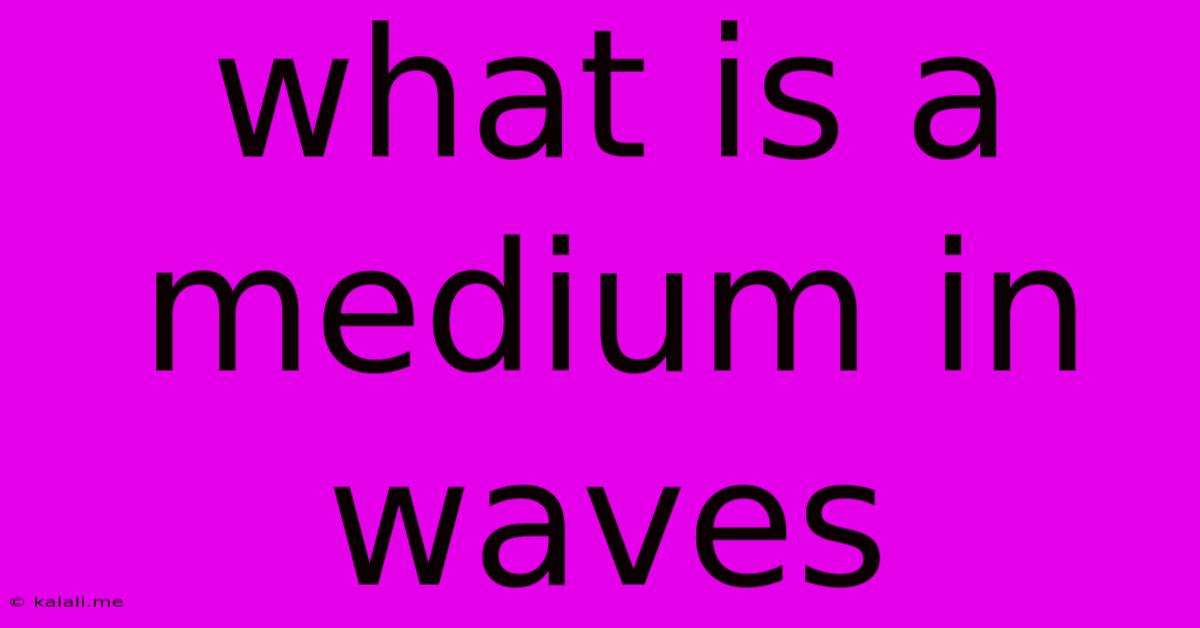What Is A Medium In Waves
Kalali
Jun 02, 2025 · 3 min read

Table of Contents
What is a Medium in Waves? Understanding Wave Propagation
Have you ever thrown a pebble into a still pond and watched the ripples spread outward? Those ripples are a perfect example of waves traveling through a medium. But what exactly is a medium in the context of waves? This article will explore this fundamental concept in physics, explaining different types of media and how they affect wave behavior. Understanding the medium is crucial to grasping how waves transmit energy and information.
Defining the Medium
In physics, a medium is the substance or material through which a wave travels. It's the stuff that the wave "wiggles" through, transferring energy from one point to another without actually transporting the medium itself. Think of it like a chain reaction – each particle in the medium interacts with its neighbor, passing the disturbance along. Without a medium, most waves cannot propagate.
Types of Media
Waves can travel through various media, each with its own properties affecting wave speed and behavior:
-
Solid: Solids are characterized by strong intermolecular forces, allowing waves to travel relatively quickly. Examples include sound waves traveling through a metal bar or seismic waves through the Earth's crust. The rigidity of the solid influences the types of waves that can propagate – longitudinal (compressional) and transverse (shear) waves are both possible.
-
Liquid: Liquids have weaker intermolecular forces than solids. While they can support longitudinal waves (like sound), they typically cannot support transverse waves because the molecules can easily slide past one another. The speed of sound in a liquid is generally slower than in a solid.
-
Gas: Gases have very weak intermolecular forces, resulting in slower wave propagation speeds than in solids or liquids. Like liquids, gases primarily transmit longitudinal waves. The density and temperature of the gas influence the speed of sound.
-
Vacuum: This is a special case. Electromagnetic waves, such as light and radio waves, are the exception; they do not require a medium to propagate and can travel through a vacuum. This is because electromagnetic waves are self-propagating disturbances in the electromagnetic field itself.
How the Medium Affects Waves
The properties of the medium directly influence several characteristics of wave propagation:
-
Speed: The speed of a wave depends on the elastic properties and density of the medium. Generally, waves travel faster in denser, more rigid media.
-
Wavelength: The wavelength (distance between successive crests or troughs) is affected by the speed and frequency of the wave. Changes in the medium can alter the wavelength.
-
Amplitude: The amplitude (maximum displacement from equilibrium) can be affected by the medium's ability to absorb or reflect wave energy.
-
Damping: The medium can absorb some of the wave's energy, causing it to dampen or decrease in amplitude over distance.
Examples of Mediums in Action
-
Sound waves: These are longitudinal waves requiring a medium like air, water, or solids to travel. That's why you can't hear sound in a vacuum.
-
Water waves: These are surface waves involving the interaction of water molecules. The depth of the water significantly impacts wave speed and behavior.
-
Seismic waves: These waves travel through the Earth's layers (solid, liquid, and partially molten materials), providing crucial information about the planet's interior.
-
Light waves: These are electromagnetic waves that travel through a vacuum at the speed of light. However, their speed changes when passing through different media like air, water, or glass.
Understanding the role of the medium is crucial for comprehending a wide range of physical phenomena involving wave propagation. From the everyday experience of hearing sound to the complex processes governing seismic activity and the transmission of light, the medium's properties fundamentally shape the characteristics of waves.
Latest Posts
Latest Posts
-
Where Do Screen Recordings Go On Mac
Jun 04, 2025
-
Maskman Stage Show At 5 Heroes Korakuen Yuenchi
Jun 04, 2025
-
Wiring Diagram 30 Amp Generator Plug
Jun 04, 2025
-
What Version Of Skyrim Am I On
Jun 04, 2025
-
Words That Sound Like What They Represent
Jun 04, 2025
Related Post
Thank you for visiting our website which covers about What Is A Medium In Waves . We hope the information provided has been useful to you. Feel free to contact us if you have any questions or need further assistance. See you next time and don't miss to bookmark.